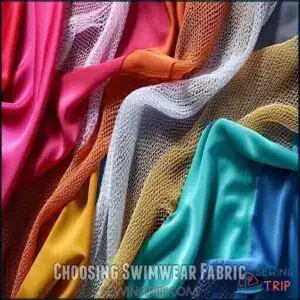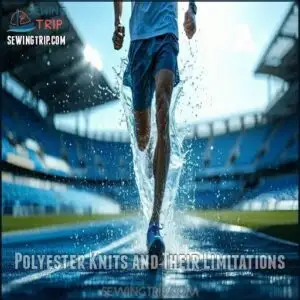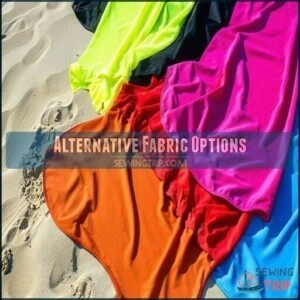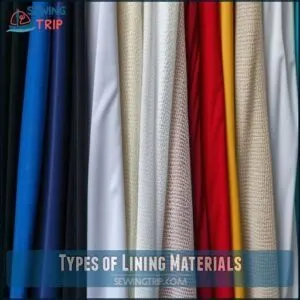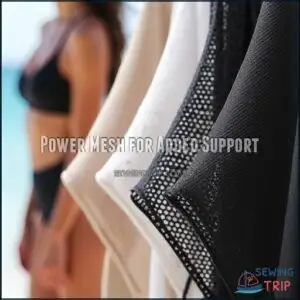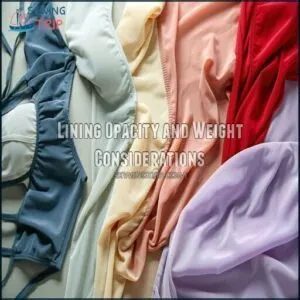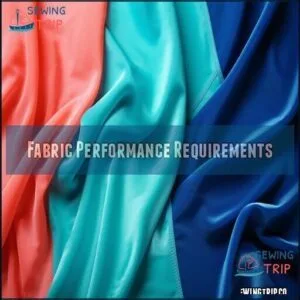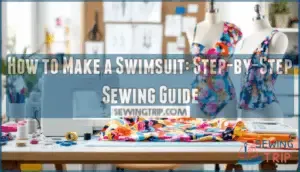This site is supported by our readers. We may earn a commission, at no cost to you, if you purchase through links.
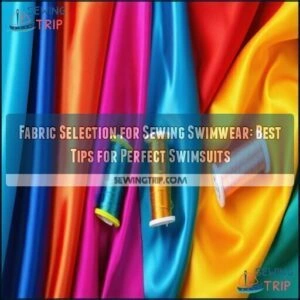
A nylon-spandex blend is your best bet—it’s strong, flexible, and hugs the body just right.
Polyester blends are also durable but don’t stretch as much, so they’re better for structured designs.
Look for chlorine- and UV-resistant options to keep your suit looking fresh.
Don’t forget lining—lightweight tricot or power mesh adds support without bulk.
And remember, swimwear fabric loves a little challenge, so stick to stretch needles and polyester thread for stress-free sewing.
Ready to make waves? Start with the perfect fabric.
Table Of Contents
Key Takeaways
- Choose a nylon-spandex blend for the best stretch, durability, and comfort when sewing swimwear.
- Look for chlorine- and UV-resistant fabrics to keep your swimsuits vibrant and long-lasting.
- Use lightweight tricot or power mesh as lining for added support without adding bulk.
- Stick to stretch needles and polyester thread to prevent skipped stitches and ensure stress-free sewing.
Choosing Swimwear Fabric
When choosing swimwear fabric, focus on stretch, durability, and water resistance to guarantee a great fit and long-lasting wear.
Stretch and durability are the secrets to swimwear that fits perfectly, moves effortlessly, and lasts through every adventure.
Pick a nylon-spandex blend with 4-way stretch for comfort and recovery since natural fibers like cotton won’t hold up in water.
Key Characteristics of Swimwear Fabric
Swimwear fabric is all about performance. Look for stretch fabric with 4-way stretch properties for a snug fit.
Pick materials with chlorine resistance and UV protection to keep them durable and fade-free. Avoid fabrics that absorb water heavily—you don’t want a soggy suit!
Lightweight options with low water absorption guarantee a quick-drying, comfortable experience every time you take the plunge.
Importance of Fabric Stretch and Recovery
The right stretch fabric is like a swimsuit’s backbone—it keeps everything in place.
With 4-way stretch and excellent fabric recovery, swimwear fabric guarantees shape retention, sagging prevention, and fit maintenance.
Poor stretch risks comfort and performance, leaving you tugging at seams.
Prioritize stretch and recovery for a suit that moves with you, looks great, and performs beautifully, providing a great backbone.
Factors Affecting Fabric Durability
Durability in swimwear fabric depends on resisting chlorine exposure, saltwater effects, and sunlight degradation.
Opt for chlorine-resistant and saltwater-resistant blends like nylon-spandex or polyester-spandex.
UV protection guarantees fibers resist sun damage while staying strong.
Look for fabrics with pilling resistance and quick drying.
Durable swimwear thrives on fiber strength and elasticity, keeping your swimsuit alive through countless beach days.
Ideal Fabric Composition
When picking fabric for swimwear, you’ll want a combination that offers durability, stretch, and recovery.
Blends like nylon-spandex or polyester-spandex are the gold standard, giving your suit the strength to last and the flexibility to move with you, which provides recovery.
Nylon and Spandex Blend
A nylon-spandex blend is the gold standard for swimwear sewing, offering exceptional stretch properties and excellent recovery.
Nylon-spandex blends deliver unbeatable stretch, recovery, and durability, making them the ultimate choice for flawless swimwear.
It’s soft, durable, and resists sagging while maintaining a flattering sheen.
Perfect for swimwear fabric, the nylon-spandex blend stands out for its blend durability, color retention, and flexibility.
It’s a cost-effective, versatile choice ensuring your swimsuit fits snugly and moves with you, providing excellent recovery.
Polyester Knits and Their Limitations
Although polyester knits offer cost savings and resist pilling, they’re not perfect for swimwear sewing.
These fabrics struggle with limited stretch and can fade or degrade in chlorine or sunlight over time.
While swimsuit durability might suffer, polyester’s quick-drying nature is a plus.
Just prioritize quality when using polyester swimwear fabrics to balance performance and longevity.
Because it offers excellent moisture-wicking, polyester is often used in sportswear and provides excellent performance.
Alternative Fabric Options
If polyester’s challenges have you second-guessing, explore alternative swimwear fabrics like neoprene and scuba for their durability and structure.
Repreve, made from recycled materials, offers sustainability without skimping on performance.
Comparing blends? Look for fits that balance stretch, recovery, and comfort in your swimwear fabric selection.
Each swimsuit material brings unique perks—choose wisely for the perfect match of style and function!
Lining and Support Options
When sewing swimwear, your choice of lining and support materials can make or break the final fit and comfort.
From lightweight nylon to sturdy power mesh, it’s important to match the lining to your fabric and support needs for a polished, secure finish.
Types of Lining Materials
Swimsuit lining matters more than you’d think! Nylon linings are soft and stretchy, while polyester blends with spandex add durability.
For lightweight swimwear fabric, self-lining works but can feel bulky. Look for lining weight and opacity levels to avoid transparency.
Many options exist for nylon swimsuit material to examine. The lining fabric you choose—like tricot or 100% nylon—adds comfort, support, and structure to your designs.
Power Mesh for Added Support
If you’re looking for extra support in swimwear construction, power mesh is a great option.
Its lightweight, stretchy design boosts stability and comfort, making it an excellent addition to swimwear lining.
Power mesh can also serve as breathable lining material, enhancing the garment’s overall comfort.
Consider its mesh composition and breathability factors when choosing the right support levels.
It’s versatile, cost-effective, and a reliable alternative support compared to standard lining fabric.
Lining Opacity and Weight Considerations
Choosing the right swimsuit lining is about balancing fabric opacity, weight impact, and comfort factors.
Thin linings work well for stable fabrics but can lack support enhancement in lighter materials. Heavier linings add fabric stability and prevent transparency, especially in wet conditions.
Understanding swimwear lining options is vital for achieving the desired effect.
Consider how the lining fabric’s weight affects stretch and fit to guarantee your swimwear looks great in and out of water.
Elastic and Notions Selection
When you’re picking elastic and notions for swimwear, it’s all about strength, stretch, and durability.
Choose materials like chlorine-resistant elastic, strong polyester thread, and stretch needles to guarantee your swimsuit holds up beautifully in and out of the water, with durability.
Chlorine-Resistant Elastic Options
Chlorine-resistant elastic is a must for durable swimwear.
It withstands wear from pools, saltwater, and sun without losing stretch or shape.
Here are some top options:
- Rubber elastic offers flexibility and long lifespan, outlasting cotton-wrapped alternatives.
- Clear elastic stretches well but ages faster in UV light.
- Fulflex elastic provides consistent performance and is a swim-specific elastic favorite.
For purchasing, consider a chlorine resistant option.
Suitable Thread Types for Swimwear
When sewing swimwear, polyester thread is a must—it’s strong, chlorine-resistant, and perfect for zigzag stitches and serger thread.
Wooly nylon adds flexibility for stretch stitches, maintaining swimsuit care and durability.
Always color-match the thread to your fabric for a polished look. For swimwear maintenance, choose threads that hold up under stress, sun, and frequent use.
Recommended Needles for Stretch Fabrics
After threading your machine with durable swimwear thread, grab the right needle to prevent skipped stitches and snags.
A stretch needle with rounded points is perfect for sewing high stretch fabrics.
Here’s what works best:
- Needle Types: Ballpoint or stretch needles are must-haves.
- Needle Size: Start with 75/11 or 90/14.
- Stretch Needlepoints guarantee smooth stitching.
For superior results, consider how thread properties matter in your fabric choice.
Sewing Techniques for Swimwear
When sewing swimwear, focusing on proper techniques guarantees a professional finish and lasting fit.
Mastering stretch stitches, precise cutting, and elastic application will help your swimsuit stand up to water, sun, and regular wear, ensuring a professional finish.
Cutting and Grainline Alignment
When cutting swimwear fabrics, use single-layer cutting for accuracy.
A rotary cutter and pattern weights help prevent shifting.
Always align patterns with the grainline for proper stretch direction, vital to swimsuit fit.
Double-check grainline markings to confirm measurements stay true.
Stretch fabric demands precision—misaligned cuts can throw off your project.
A little patience now saves big headaches later!
Stretch Stitches for Seams
Achieving smooth seams in swimwear fabrics requires stretch stitches like the Zigzag Stitch, Triple Zigzag, or Lightning Bolt.
These stitches let seams in your swimsuit stretch without breaking.
A serger isn’t mandatory—your regular machine works with these options.
One such option is the lightning stitch design, suitable for various stretch fabric weights.
Stick to a 3/8-inch seam allowance and test stitches on scraps.
These sewing techniques guarantee sturdy swimsuit construction.
Applying Elastic to Swimwear
To perfect swimsuit construction, mastering swimwear elastic application is key.
Start by evenly clipping the chlorine-resistant elastic along edges to prevent rolling. Use the right elastic placement—typically just inside the seamline.
Adjust elastic tension to match fabric stretch and guarantee a snug fit. For stitch selection, a zigzag or triple zigzag stitch works best.
Elastic finishing guarantees durability and comfort.
Fabric Performance Requirements
When sewing swimwear, you need fabric that resists water, dries quickly, and withstands exposure to sun, chlorine, and salt.
It’s also essential for the material to provide comfort, stretch, and a full range of movement without losing its shape, which is crucial for swimwear.
Water Resistance and Quick Drying
Swimwear fabrics should wick water while staying light.
Nylon spandex and polyester spandex blends excel here, offering low saturation points and quick drying. Features like hydrophobic treatments and tight fiber weaves improve performance.
Check for:
- Quick-drying fabric with proven drying time tests.
- Salt water resistant and chlorine-resistant fibers.
- Breathability factors, ensuring comfort without sacrificing durability.
UV Protection and Sun Damage Resistance
Swimwear fabrics with UV Ratings like UPF 50+ shield your skin by blocking harmful rays and extending the fabric lifespan.
Tightly woven materials reduce sun exposure, while protective finishes resist fading from UV damage.
Whether you’re shopping swimwear fabrics online or picking UV-protected materials in-store, prioritize nylon-spandex blends or polyester for skin safety and durability under the sun.
Comfort and Ease of Movement
A good swimwear fit isn’t just about looks—it’s about freedom to move.
Choose nylon-spandex with 4-way stretch for a breathable fabric that hugs your body while reducing friction.
Compression fabric adds support without restricting your range of motion.
Thoughtful seam placement guarantees comfort, while fabric breathability keeps you cool during activity.
Prioritize stretch and fit considerations for effortless movement.
Sourcing Swimwear Fabric
Finding the right swimwear fabric is easier when you know where to look and what to prioritize.
Focus on quality, stretch, and durability to guarantee your swimsuit fits well and also stands up to wear.
Recommended Suppliers for Swimwear Fabric
If you’re after high-quality swimwear fabric, online fabric stores like Mood Fabrics, Fabricmart, and Fabric Fairy offer stellar options.
For budget options or small-scale projects, check local shops or suppliers like Core Fabrics.
Fabric mills often have minimum orders but provide unique finds, and exploring these sources can help you discover quality, stretchable materials perfect for custom swimsuits.
Factors to Consider When Buying Fabric
Choosing the right swimwear fabric starts with attention to detail.
Keep these tips in mind:
- Fiber Content: Look for nylon spandex blends with 4-way stretch.
- Fabric Weight: Lightweight options work for bikinis; heavier ones offer extra coverage.
- Colorfastness: Verify it resists fading in chlorine and sunlight.
- Print Scale & Hand Feel: Test patterns and softness for comfort.
Many prefer polyester PBT fabric for its durability.
Tips for Working With Swimwear Fabric
Working with swimwear fabric can feel tricky, but it’s manageable with the right approach.
Use stretch needles to prevent skipped stitches on nylon spandex, and adjust stitch tension for smooth seams that hold.
A rotary cutter minimizes shifting when cutting 4-way stretch fabrics.
Finish seams cleanly to avoid fraying, and evenly stretch elastic during application for a snug, comfortable swimsuit.
Frequently Asked Questions (FAQs)
What is the best thread for sewing swimsuits?
Did you know polyester thread has unbeatable durability in chlorine and saltwater?
For swimsuits, it’s your best bet—strong, resilient, and stretch-friendly.
Skip cotton thread; it won’t last after a few pool dives!
Which material would make the best swimwear?
You’ll get the best swimwear from a blend of 80-90% nylon and 10-20% spandex.
It dries quickly, stretches beautifully, and resists chlorine.
Plus, it’s comfy, durable, and perfect for those poolside adventures!
Can you sew swimwear on a regular sewing machine?
You can absolutely sew swimwear on a regular sewing machine.
Use a zigzag or lightning bolt stitch, stretch needles, and polyester thread.
Just go slow, avoid stretching fabric too much, and test on scraps first.
How do I prevent swimwear fabric fraying?
Imagine trimming your swimsuit’s edge, and threads unravel like a loose sweater.
To prevent fraying, always use a serger or overlock stitch, seal edges with a zigzag stitch, and select durable polyester threads for strength.
What fabrics work for reversible swimsuits?
For reversible swimsuits, use nylon-spandex or polyester-spandex blends with 4-way stretch.
Go for smooth, lightweight fabrics—opaque and durable on both sides.
Choose designs resistant to chlorine, UV, and wear; avoid bulk to guarantee comfort.
Can swimwear fabric handle heavy embellishments?
Swimwear fabric can handle light embellishments like beads or sequins, but heavy ones may strain the material or affect stretch.
Balance durability with design—choose embellishments wisely to keep your swimsuit flexible and comfy in the water.
How do patterns affect swimwear stretch?
Patterns can either make or break swimwear stretch.
If your pattern ignores the fabric’s stretch direction or elasticity, you’ll end up with saggy suits or too-tight seams.
Always align patterns with the fabric’s stretch!
Is layering fabrics ideal for modesty?
Layering fabrics boosts modesty by reducing transparency, especially when wet.
Choose lightweight, breathable linings like power mesh or nylon that add coverage without bulk.
It’s a smart way to balance comfort and support effectively.
Conclusion
It’s no surprise that fabric selection for sewing swimwear can make or break your project.
Choosing a nylon-spandex blend guarantees flexibility, while polyester works for more structured designs.
Don’t skip chlorine- and UV-resistant options to keep your suit looking great longer.
Add lightweight tricot or power mesh for support without bulk.
Pair these with stretch needles and polyester thread for easy construction.
With the right materials, you’ll create swimwear that’s stylish, durable, and ready for action.
- https://helensclosetpatterns.com/blogs/helens-closet/top-10-tips-for-sewing-swimwear
- https://www.seamwork.com/sewing-tutorials/swimwear-basics?srsltid=AfmBOor8Fxkq_93PgB3STC8ttX7z53jCHJnZG7LMWmPYohc7X0JmXmaD
- https://threadistry.com/blog/swimsuit-fabrics/?srsltid=AfmBOoqG3BDwCzrx4BYCgS90H4FLs6Vq8bTFbJGzYBO93vhwt8dQ3DzV
- https://www.moodfabrics.com/applications/swimwear-fabrics
- https://knitfabric.com/swimsuit-fabric/?srsltid=AfmBOoqjGNWlRemNWUAERGrvziNGD_iVqCMKSbepxx-0ZwIM76hx0Z5K

